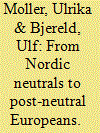| Srl | Item |
| 1 |
ID:
101470


|
|
|
|
|
| Publication |
2010.
|
| Summary/Abstract |
This article analyses the foreign policy of two post-neutral EU member states, Sweden and Finland. Both these Nordic states have adjusted their past policies of neutrality in favour of extended participation in the European and transatlantic security community. Yet within a similar and comparable pattern of change, there are two very significant differences between them: their views towards future membership in NATO and their choice of military strategy. The article utilizes an analytical framework that treats neutrality as an institutionalized idea containing causal and principled beliefs. The persistence of neutrality as a guiding principle of policy depends on feedback regarding: (1) its strategic usefulness (implications for security) as well as (2) its social appropriateness (implications for identity). The feedback mechanisms are related in the sense that the self-interested element of military non-alignment for the sake of security needs to be compensated by an appropriate role, such as demonstrating responsibility and engagement in international issues. Having taken a more autonomous decision, although with a historical record of shortcomings as regards declared neutrality, Sweden has been more dependent than Finland in ensuring that its respective policy of neutrality is complemented by an appropriate international role. This was possible during the Cold War, yet became increasingly difficult after the collapse of the bipolar world order. Thus, the analysis undertaken suggests, paradoxically, that in order to remain militarily non-aligned, Sweden has come to favour a more European outlook at the expense of the integrity of its policy of neutrality.
|
|
|
|
|
|
|
|
|
|
|
|
|
|
|
|
| 2 |
ID:
186206


|
|
|
|
|
| Summary/Abstract |
This article analyses how Sweden has adapted to the worsened security situation in its vicinity following Russia’s illegal annexation of Crimea and war in Eastern Ukraine. The paper builds on security policy research focused on neoclassic realism and small state strategies in order to explore how the, broadly unknown, security policy from 2009 has been implemented in practice since 2014, through what observers call the “Hultqvist doctrine.” The aim is to bring clarity to how the Hultqvist doctrine best can be understood – as a non-aligned or an integration policy? – and how the strategy relates to both systemic forces and domestic circumstances. The paper addresses the puzzle posed by structural realism, that the systemic forces would work to encourage Sweden to align in face of the threat that emerged in 2014. Still, Sweden has resisted NATO membership. To this end, I construct and apply an analytical framework that not only reveals the degree of novelty in the doctrine, but also allows for an evaluation of integration in three dimensions – openness, inclusiveness and comprehensiveness – in combination with a screening dimension. Following neoclassical realism, the study furthermore identifies domestic conditions that hinder policy flexibility.
|
|
|
|
|
|
|
|
|
|
|
|
|
|
|
|